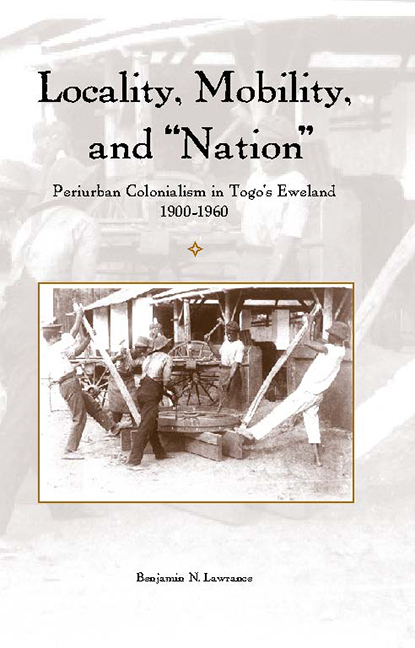Book contents
- Frontmatter
- Dedication
- Contents
- List of Illustrations
- Preface
- Notes on Orthography
- Map
- Introduction: Conceptualizing Periurban Colonialism in Sub-Saharan Africa
- 1 Mobility, Locality, and Ewe Identity in Periurban Eweland
- 2 Intervention and Dissent: Manufacturing the Model Periurban Chief
- 3 Crisis in an Ewe “Capital”: The Periurban Zone Descends on t he City
- 4 Vodou and Resistance: Politico-Religious Crises in t he Periurban Landscape
- 5 The German Togo-Bund and the Periurban Manifestations of “Nation”
- 6 From Eweland to la République Togolaise: Le Guide du Togo and the Periurban Circulation of Knowledge
- Epilogue
- Notes
- Bibliography
- Index
4 - Vodou and Resistance: Politico-Religious Crises in t he Periurban Landscape
Published online by Cambridge University Press: 11 May 2017
- Frontmatter
- Dedication
- Contents
- List of Illustrations
- Preface
- Notes on Orthography
- Map
- Introduction: Conceptualizing Periurban Colonialism in Sub-Saharan Africa
- 1 Mobility, Locality, and Ewe Identity in Periurban Eweland
- 2 Intervention and Dissent: Manufacturing the Model Periurban Chief
- 3 Crisis in an Ewe “Capital”: The Periurban Zone Descends on t he City
- 4 Vodou and Resistance: Politico-Religious Crises in t he Periurban Landscape
- 5 The German Togo-Bund and the Periurban Manifestations of “Nation”
- 6 From Eweland to la République Togolaise: Le Guide du Togo and the Periurban Circulation of Knowledge
- Epilogue
- Notes
- Bibliography
- Index
Summary
Chiefs and Notables have seen just how strikingly goro—in enabling them to procure wealth, and in restoring to them the influence they have lost— puts in their hands, and the things that result with it, the reconquest of local autonomy.
—Monsignor Jean-Marie Cessou, 1936In the summer of 1935, Datschi a clerk, staggered into the office of the commandant of the Cercle of Aného. He had come by bicycle and foot over 20 miles to alert his superior to a horrific event in his home village of TchékpoDévé. Chief Aglao and the head vodou priest had killed and eaten his twelve-year-old daughter the day before. Immediately, the unwieldy forces of colonial law enforcement sprang into action. The commandant dispatched his French assistant commandant and several African gendarmes by car to Tchékpo-Dévé. They arrived in the village only forty-five minutes later and hastily searched for Aglao and his “consorts,” i.e., his “shrine adherents.” Aglao, Honsou, and others ran for their lives but were soon captured, shackled and thrown in the car. Several others fled into the forest and made their way toward the frontier with British Togoland. The gendarmes located the vodou shrine. After carrying away numerous body parts, bones, and skulls, they set about burning the huts and destroying all vestiges of the religious site. That evening they returned to Aného with their evidence and threw their captives in jail.
Among the most striking developments in periurban Eweland during the French mandate are the simultaneous emergence of independent churches and the resurgence of interest in healing vodou cults. The arrival of British and French forces in German Togo led swiftly to the quasi-autonomous operation both of Protestant evangelical and Roman Catholic churches. Within a few years the former was operating as the Ewe Presbyterian Church, while the latter was struggling to find the necessary European leadership. At about the same time, colonial officials noted the appearance of what seemed to be many new Ewe vodou forms.
- Type
- Chapter
- Information
- Locality, Mobility, and "Nation"Periurban Colonialism in Togo's Eweland, 1900–1960, pp. 90 - 120Publisher: Boydell & BrewerPrint publication year: 2007

